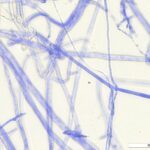What are Trichoderma fungi?
Trichoderma are fungi that are found in the environment and especially in the soil all over the world. Under optimal conditions, they can grow up to 2 cm a day. For this, sufficient water, nutrients and soil temperatures between 20 and 25 °C must be present. From about 10 °C, the conidia (asexual spores) of Trichoderma germinate. They are green-pigmented and can survive cooler temperatures (such as those that occur in winter) by going into a kind of dormancy and then germinating again as soon as the temperatures are warmer. Trichoderma itself feeds on dead organic matter and on substances excreted by the root or by mycoparasitism from other fungi.

Conidia
The green-pigmented spores of Trichoderma atrobrunneum are formed asexually by the transformation of special hyphae. They serve as dissemination organs for asexual reproduction. Source: Empa.
Chlamydospores
The thick-walled (coloured blue in the photo) survival forms of Trichoderma atrobrunneum are called chlamydospores. With the help of these chlamydospores, Trichoderma atrobrunneum can survive in this form under adverse conditions (heat, lack of nutrients) for up to decades and then germinate again as soon as the conditions are suitable. Compared to the chlamydospores, the green pigmented spores are much smaller and are produced in much higher numbers. Source: Empa.
Hyphae
Filamentous cells of Trichoderma atrobrunneum, which are divided into sections by partitions (septa). The mycelium refers to the totality of all hyphae of a fungus. Source: Empa.
Phialides und Hyphae
Phialides (singular phialide) are flask-shaped cells on which the conidia of Trichoderma atrobrunneum are formed. Source: Empa.
Modes of action of Trichoderma
Efficient use of space and nutrients
Trichoderma atrobrunneum is highly competitive for nutrients and space, as it can grow quickly and uses nutrients efficiently. Harmful fungi are thus deprived of the space and growth factors they need for their development. In addition, the high competitiveness of Trichoderma atrobrunneum is reflected in the high production of conidia and chlamydospores (survival stage of the fungus).
Trichoderma forms a symbiosis with the plant roots
Trichoderma is able to grow within the first two cell layers of the host root. This connection allows a positive use of both organisms: Trichoderma benefits from nutrients that plants excrete via the root to attract microorganisms like Trichoderma and the plant benefits from the connection in several ways:
Increased growth and enhancement of the plant’s nutrient uptake
Trichoderma produces auxins or growth hormones, which it passes on to the plant. The plant then uses auxin for its root and general growth. In addition, Trichoderma is able to make nutrients available in the soil more easily available to the plant. By producing organic acids, the pH value is reduced locally and the solubility of phosphates, micronutrients and e.g. iron etc. is increased. This makes the existing nutrients easier for the plant to access, which, in addition to the auxins, is reflected in the increased growth of the plant.
Pre-immunisation of the plant – increase of resistance
Pre-immunisation of the plant involves Trichoderma triggering the production of messenger substances (e.g. salicylic acid or jasmonic acid) throughout the plant. Messengers are signalling molecules and warn the entire plant when a pest is attacking the plant. Normally, these messenger substances are only produced when a pest occurs. With Trichoderma, this happens beforehand. This allows the plant to react more quickly to a pest attack, making it more resistant.




